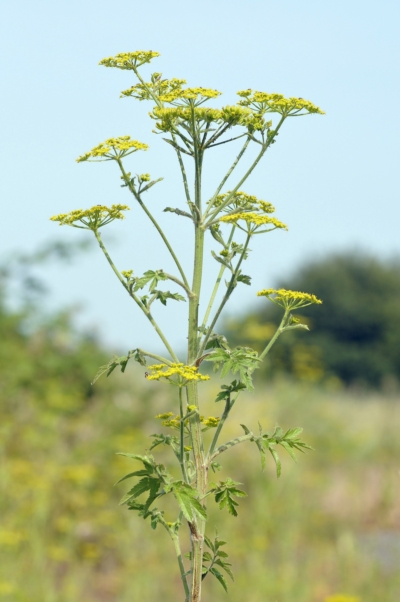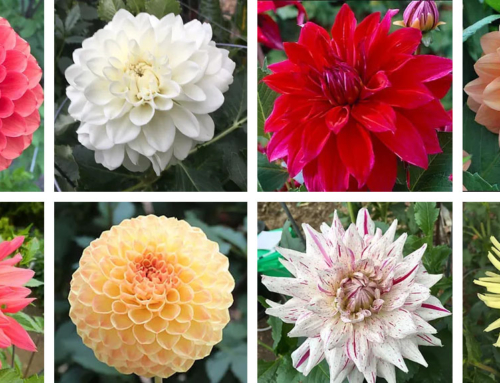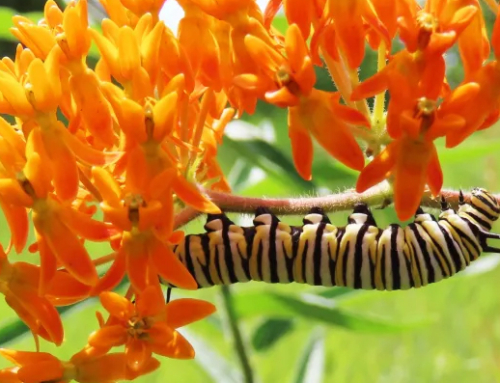How is wild parsnip related to the vegetable that I love to sauté in butter? Like cultivated parsnips, its roots are edible. But wild parsnip’s sap can cause severe blisters and burns. Don’t even think about touching it without protective gear!
Native to Europe and Asia, wild parsnip was likely brought to North America by European settlers. It escaped cultivated gardens and was spread from seed by human and animal activity and through the movement of wind and water. Wild parsnip is found throughout the U.S. and in most Minnesota counties, particularly in the southeastern part of the state, and is classified as a “noxious weed” by the Minnesota Department of Agriculture.
Identifying Wild Parsnip
Wild parsnip (Pastinaca sativa) is often seen along roadsides and rail rights-of-way as well as on trails and in natural areas, pastures, forest and field margins, waste areas, and idle land. Plants can tolerate dry, mesic (moderate), or wet soils, but they don’t grow well in shaded areas.
Typically, wild parsnip has a two-year life-cycle. In its first year, plants form a clump of low-lying leaves called a basal rosette. Wild parsnip rosettes are one of the first plants to become green in the spring and remain green later into the fall than many native plants. In its second year, plants grow a tall stalk, flower, set seed, and die.
Wild parsnip has a long, thick taproot that looks and smells like cultivated parsnip. Mature plants can reach four to six feet tall and have saw-tooth-edged leaves arranged in pairs along the stalk. Its stems are hollow, grooved, and topped with flat flower clusters ranging from two to six inches wide that hold many five-petaled yellow flowers. Wild parsnip blooms from June through late August. Several weeks after flowering, the plant produces small, straw-colored oval seeds and the plant dies. Seeds can remain viable in the soil for four years.
Why Is Wild Parsnip Detrimental?
Wild parsnip is highly invasive and, if ignored, can spread rapidly, replacing valuable native animal and plant habitat. It reduces the quality of agricultural forage crops and can harm livestock if ingested. The plant sap contains toxic chemicals that are activated by sunlight and cause serious burns and blisters to human skin after contact, a condition known as “phytophotodermatits.”
Controlling and Preventing Wild Parsnip
Control and prevention of wild parsnip typically takes two forms: mechanical, which involves removing plants from the environment physically through cutting or pulling, and chemical, in which herbicides are used to kill plants and inhibit regrowth.
Mechanical control works best for smaller numbers of plants. Pull plants by hand or sever their tap roots one to two inches below the soil surface with a sharp spade or shovel before seeds set. Mowing or cutting stands larger stands of wild parsnip before it flowers in June will kill most mature plants and reduce seed production. Mowing throughout the season and for several subsequent years may be necessary to prevent re-sprouting and to cut newly bolted (rapidly growing) plants. After mowing, wash equipment to prevent moving seed into new areas. Be sure to wear protective clothing—long pants, long sleeves, and sturdy gloves—whenever handling wild parsnip to avoid contact with the plant’s toxic sap.
Chemical control can be undertaken with nonselective late fall or early spring applications of glyphosate or with selective applications of 2,4-D to target rosettes and newly bolted plants before they flower. Several years of treatment may be required to prevent wild parsnip from re-seeding and to grow vegetation to compete with the invasive plant. Follow package instructions or contact a licensed herbicide applicator.
Kill—but do not remove wild parsnip—from an infested area whenever possible. If you do need to move plant waste, contact an authorized disposal site to be sure that it’s equipped to process compost at high enough temperatures to accept noxious weeds. Do not compost wild parsnip at home.
The Minnesota Department of Natural Resources recommends controlling and preventing the growth of invasive species by:
- REMOVING plants, animals, and mud from boots, clothes, gear, pets, and vehicles.
- CLEANING your gear before entering and leaving recreation sites; cleaning the gardening tools that you use at home.
- STAYING on designated roads and trails.
- PLANTING non-invasive species.
If you see new patches of wild parsnip in public areas, report them to one of the following authorities: EDDSMapS Midwest; Arrest the Pest (or 888-545-6684), or local county agricultural inspectors.
By Laura Austrian, Hennepin County Master Gardener volunteer
Resources:
https://www.dnr.state.mn.us/invasives/terrestrialplants/herbaceous/wildparsnip.html
https://www.mda.state.mn.us/plants/pestmanagement/weedcontrol/noxiouslist/wildparsnip
https://extension.umn.edu/identify-invasive-species/wild-parsnip
https://apps.extension.umn.edu/garden/diagnose/weed/idlist.html#WParsnip
http://www.invadingspecies.com/wild-parsnip






